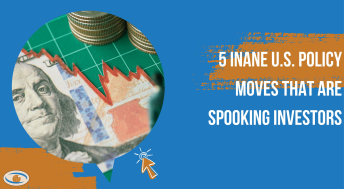1. Chilling Drop: Canadian Utility Stocks' Plummet
It has been a bloody and brutal few months for Canadian utility stocks, as investors worry of the ramifications from a ‘higher-for-longer’ theme. Utility stocks were particularly bruised as these names are well-known to carry significantly high debt loads. It was not only the high debt burdens that utility names hold, but also the weakening prospects of the yield provided by utility companies versus a relatively risk-free GIC or high-interest savings ETF which are yielding more than 5%. The iShares S&P/TSX Capped Utilities ETF (XUT) posted a 16% rolling-three month decline, matching some of its worst drawdowns from the past.
2. Canadian Bond Prices Haunted by Soaring Yields
Bond prices are inversely correlated with interest rates, and thus, as interest rates rise, bond prices fall. Investors have traditionally liked bonds for their low correlation with the equities market, but over the past three years, this low correlation has led to a 35% decline for the iShares Core Canadian Long-Term Bond ETF (XLB). This decline comes amid a meteoric rise in the Canadian 10-year bond yield from 0.6% to 4.1%.
3. Eerie Stagnation: Major Indices Trapped in a 2.5-Year Time Warp
The major financial indices, the S&P 500, the Nasdaq composite, and the TSX, have all been mostly flat since mid-2021. This eerie stagnation has occurred through a series of melt-ups, meltdowns, and lots of choppy sideways action. The past 2.5 years have been plagued by high and rising inflation, elevated interest rates, and bursts of economic shocks, leading to a stagnant stock market.
4. Ghastly Growth: Canadian GDP Lingers Below the Average
Canadian GDP spiked in 2021 to 2022 following a sharp move lower in 2020, however, it has since begun sliding lower throughout 2023. Canada’s year-over-year GDP growth is now at a meager 1.12%, lower than its long-term average of 2.61% dating back to 1970. Rising interest rates have been putting pressure on businesses and individuals across the country, and interest-rate sensitive industries such as housing, manufacturing, and financial services have been seeing the impacts of a worsening global macro environment.
5. Earnings and Revenue Revisions Cast a Shadow on These Canadian Stocks
In the graph below, we have highlighted the Canadian companies that have both negative earnings and revenue estimate revisions for the next fiscal year. This combination of both negative earnings and sales revisions means that these businesses are expected to see worse growth rates in the next year than previously expected. Some of the names with the larger negative estimate revisions include: West Fraser Timber (WFG), Nutrien (NTR), Tourmaline (TOU), Cenovus Energy (CVE), and Imperial Oil (IMO). Most notably, these are all companies that operate in the energy or materials industries. This list does not necessarily imply that they are bad companies, but more so that their forward earnings and revenue growth rates are anticipated to be worse than previously expected.
Source: Koyfin
Analysts of 5i Research responsible for this report do not have a financial or other interest in the iShares S&P/TSX Capped Utilities Index ETF (XUT) or the iShares Core Canadian Long Term Bond ETF (XLB).
The i2i Fund does not have a financial or other interest in the iShares S&P/TSX Capped Utilities Index ETF (XUT) or the iShares Core Canadian Long Term Bond ETF (XLB).
Research for Today, Invest for Tomorrow.

Twitter: @5iChris






Comments
Login to post a comment.